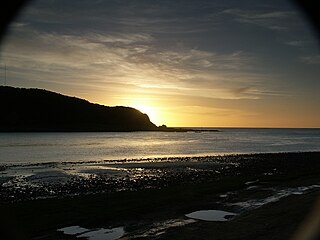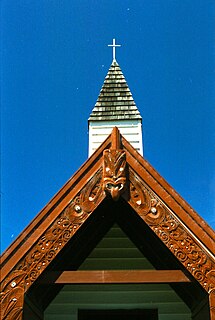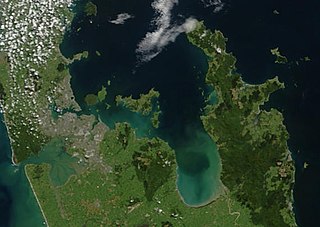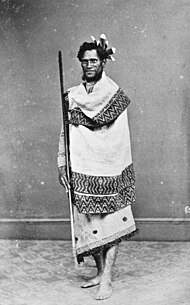
The New Zealand Wars were a series of armed conflicts that took place in New Zealand from 1845 to 1872 between the New Zealand government and the Māori people. Until at least the 1980s, European New Zealanders referred to them as the Māori wars; the historian James Belich was one of the first to refer to them as the "New Zealand wars", in his 1987 book The New Zealand wars and the Victorian interpretation of racial conflict.
Tainui is a tribal waka confederation of New Zealand Māori iwi. The Tainui confederation comprises four principal related Māori iwi of the central North Island of New Zealand: Hauraki, Ngāti Maniapoto, Ngāti Raukawa and Waikato. There are other Tainui iwi whose tribal areas lay outside the traditional Tainui boundaries - Ngāi Tai in the Bay of Plenty, Ngati Raukawa, and Ngāti Toa in the Horowhenua, Kapiti region and Ngāti Rārua and Ngāti Koata in the northern South Island.

Ngāti Kahungunu is a Māori iwi (tribe) located along the eastern coast of the North Island of New Zealand. The iwi is traditionally centred in the Hawke's Bay and Wairārapa regions.

Ngāti Toa, Ngāti Toarangatira or Ngāti Toa Rangatira, is a Māori iwi (tribe) in the lower North Island and upper South Island of New Zealand. Its rohe extends from Whanganui in the north, Palmerston North in the east, and Kaikoura and Hokitika in the south. Ngāti Toa remains a small iwi with a population of only about 4500. It has four marae: Takapūwāhia and Hongoeka in Porirua, and Whakatū and Wairau in the north of the South Island. Ngāti Toa's governing body has the name Te Rūnanga o Toa Rangatira.

Ngāti Maniapoto is an iwi (tribe) based in the Waikato-Waitomo region of New Zealand's North Island. It is part of the Tainui confederation, the members of which trace their whakapapa (genealogy) back to people who arrived in New Zealand on the waka (canoe) Tainui. The 2006 New Zealand census shows the iwi to have a membership of 33,627, making it the 7th biggest iwi in New Zealand.

Stephens Island is at the northernmost tip of the Marlborough Sounds in the South Island of New Zealand. It lies two kilometres to the northeast of Cape Stephens, the northernmost point of D'Urville Island. The island is 1.5 square kilometres in size, and rises 283 metres (928 ft) high from the sea.

Ngāti Apa is a Māori iwi (tribe) in Rangitikei District of New Zealand. Its rohe extend between the Mangawhero, Whangaehu, Turakina and Rangitīkei rivers. This area is bounded by Whanganui River in the north-west, and Manawatu River in the south-east. The marae in this district include Tini wai tara, Whangaehu, Kauangaroa, and Parewanui.
The following lists events that happened during 1921 in New Zealand.

Māori religion encompasses the various religious beliefs and practices of the Māori, the Polynesian indigenous people of New Zealand.

Ngāti Ruanui is a Māori iwi traditionally based in the Taranaki region of New Zealand. In the 2006 census, 7,035 people claimed affiliation to the iwi. However, most members now live outside the traditional areas of the iwi.

Te Āti Awa is a Māori iwi with traditional bases in the Taranaki and Wellington regions of New Zealand. Approximately 17,000 people registered their affiliation to Te Āti Awa in 2001, with around 10,000 in Taranaki, 2,000 in Wellington and around 5,000 of unspecified regional location.
Pāora Te Potangaroa was a Māori prophet and rangatira of the Ngāti Kahungunu in the Wairarapa region of the North Island of New Zealand. Little is known about his life, but he is known for having uttered an 1881 prophecy of the coming of a church that would be for the Māori people.

Rewi Manga Maniapoto (1807–1894) was a Ngāti Maniapoto chief who led rebel Kīngitanga forces during the New Zealand government Invasion of Waikato during the New Zealand Wars.

Ngāti Maru is a Māori iwi (tribe) of the Hauraki region of New Zealand. The stronghold of Ngāti Maru has been the Thames area. Ngāti Maru are descendants of Te Ngako, also known as Te Ngakohua, the son of Marutūāhu, after whom the tribe is named.

Ngāti Mutunga is a Māori iwi (tribe) of New Zealand, whose original rohe were in north Taranaki. They migrated from Taranaki, first to Wellington, and then to the Chatham Islands in the 1830s. The rohe of the iwi includes Wharekauri, Te Whanga Lagoon and Waitangi on Chatham Island, and Pitt Island, also part of the Chatham Islands. The principal marae are at Urenui in Taranaki, and the Chatham Islands.

Tuiti Makitanara, sometimes known as Sweet MacDonald, was a Māori and United Party Member of Parliament in New Zealand.

Wiremu Te Morehu Maipapa Te Wheoro (1826–1895), also known as Major Te Wheoro and later as Wiremu Te Morehu or William Morris, was a 19th-century Māori member of the House of Representatives.

Waata Pihikete Kukutai was a New Zealand Māori tribal leader, farmer and assessor. He identified with the Ngati Tipa and Waikato iwi.
This timeline sets out intertribal battles involving Māori people in what is now New Zealand.
















